It’s Nativism: Explaining the Drivers of Trump’s Popular Support
Introduction
Clifford Young personally began to question his own assumptions about Trump during the summer of 2015. At that time, Trump was in the middle of a vitriolic barrage against immigrants, or more precisely, “illegal criminal immigrants” as he would now argue.
Such a strategy, by all accounts, ran counter to what most would consider best political practices; his rhetoric should have killed his political pretensions. It didn’t; quite the reverse actually. This was quite disconcerting for analysts like me, and strongly suggested that there was more to him than spin and showbiz.
Why? What was special about Trump and his message? What about him resonated?
Many analysts tried to understand the reasons for this sustainability. The explanations vary. Some see Trump’s success through economic lenses: that he resonates with an emerging “precariat class” or “squeezed middle class” who are losing out in an increasingly globalized and automated economy.
Others argue that Trump supporters are actually authoritarian in nature and thus desire order and certainty in a world full of threats. Trump is an authoritarian; ergo, authoritarians support him. This argument seems to have had the most widespread exposure and acceptance among analysts.
Still others believe that Trump appeals to the populist, anti-elite tendencies of voters. Key here is the view that when a significant chunk of the population believes the system is broken, the environment is ripe for a populist adventurer like Trump.
Finally, at Ipsos, we believed from October 2015 that Trump’s true strength lay very simply in his anti-immigrant rhetoric. That Trump’s strong “America first”, nativist narrative resonates with the Republican base and, if toned down, could find broader popular appeal. Put differently, Trump taps into a deep fear that America’s best days are behind it; a yearning for what was; and a fear of the “other”.
So what explains Trump? Which of these factors, if any, hold water?
To date, these explanations have not been put simultaneously to the statistical test in a multivariate context. When controlling for each factor, which ones still have a significant impact on support for Trump? And which ones ultimately are just spurious correlates?
Data and Measures
To answer these questions, we conducted five polls [2] on the subject from December 28th, 2015 through April 16th, 2016. This has been an iterative process where we have tested and tweaked our measures over time. Much of this research has been published in one way or another. In the spirit of transparency, we have posted the topline for each of these polls, available via links in footnote (2) below.
To test the relative effect of each of these alterative explanations, we analyze a representative poll of respondents weighted to the general population (n=1,006; weighted by age, gender, education, and race/ethnicity). In total, we assess eight separate ideological measures detailed below.
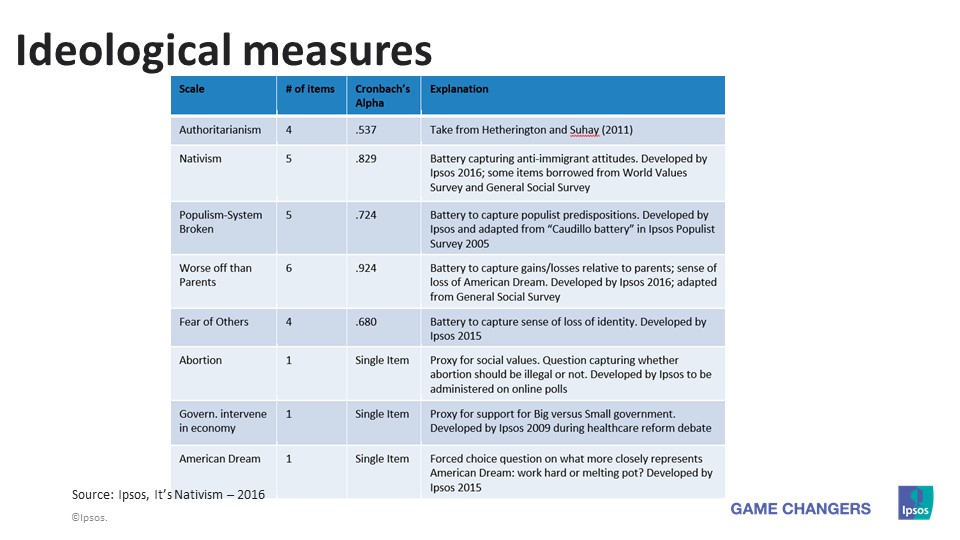
The five ideological multi-item scales employed here have good measurement properties (see specific question wording in appendix). They all are unidimensional; have decent convergent and divergent validity; and have Cronbach alpha scores ranging from .537 to .924. Cronbach alpha is a commonly used measure of reliability which is essentially the average inter-item correlation. The simple rule of thumb is that a scale with a score of .6 or more is a robust measure[3]. The Authoritarian scale is a relatively weak metric; that said, it is still in the acceptable range.
Of the five scales, only the Authoritarianism scale is borrowed in its entirety. This 4-item scale was first developed by Altemeyer[4] and later adapted by Feldman[5] and employed on the ANES. The items focus on child-rearing practices and have been shown to correlate with a wide range of politically relevant variables.
The remaining four multi-item scales all are Ipsos adaptations. Nativism is a 5-item scale which taps anti-immigrant and nativist beliefs. I borrow and adapt several items from the GSS and World Values Survey. Populism-SystemBroken is a 5-item scale. Its objective is to capture voter’s underling predisposition towards populism. Here I define populism as support for taking extra-institutional actions to fix a political system which is perceived as broken. I adapted this scale from an Ipsos poll on Latin America populism conducted in 2005. I call the battery of questions The Caudillo Syndrome: people believe the system is broken; rigged against people like them; and only a leader willing to break the rules can fix it.
WorseOff (than Parents) is a 6-item scale intended to measure one of the central tenets of the American Dream—that one will be better off than their parents. I adapted this from a single GSS question. Finally, FearofOthers is a 4-item scale developed by Ipsos in 2015. Here I was keen on tapping into the relative sense of identity loss and its impact on political behavior.
Additionally, I will use three single items as controls.
- Abortion – whether the person thinks abortion should be legal or illegal—a proxy measure for social values. We developed this item for our online polls in 2009.
- Government Intervention – whether the person wants more or less government intervention in the economy. This item was developed in 2009 during the health care reform debate.
- American Dream – forced choice question asking people what more closely comes to their notion of the American dream: is it more about working hard and getting ahead or about being a melting pot? Our own research has shown that this measure correlates strongly with being a Republican versus Democrat.
We analyse the impact of the above explanatory factors on three outcome, or dependent, variables: (1) support for Trump in the primaries among all voters; (2) support for Trump in the primaries among Republicans; and (3) likelihood to identify as a Republican. Here I use identity as a Republican as an analytical control and benchmark.
Ultimately, we are interested in reproducing, albeit imperfectly, voter decision making: what factors, in other words, are more (or less) important in determining support for Trump? To do this, we employ two separate estimators of impact: (1) logistic regression and (2) Bayesian Network Analysis[6].
Both models estimate the relative impact of each potential explanatory factor. Bayesian network analysis, in turn, identifies the inter-connectedness and causality of the explanatory factors—using a very exciting proprietary method developed at Ipsos.
Why is Bayes net cool? In cognitive psychology parlance, our memory is associative. The key is to identify this interconnectedness and causal sequencing. Practically speaking, the ability to identify memory clusters enhances our understanding of key behavioral triggers and allows us to optimise messaging for full impact.
So what do we find?
Simply put, it is all about nativism! Indeed, across all methods, the findings are incredibly consistent—those who support Trump are much more likely to hold strong nativist and anti-immigrant beliefs, controlling for other ideological and demographic variables. Most importantly, nativism is the most impactful driver of support for Trump. Let’s examine in detail.
Logistic Regression Analysis
Again, I estimate three models using three distinct dependent variables. In addition to the eight ideological variables mentioned above, I include standard demographic variables as controls: age, gender, education, and race/ethnicity.
Additionally, for easy perusal, I report each factor’s impact as the percent explained variance. This places all the explanatory factors on a standard 100% scale for easy understanding.
Two caveats. First, the percent explained variance is a proxy metric as it excludes the overlapping variance among independent variables. Second, I convert logistic regression logit coefficients to standardised beta scores like those found in linear regression. This is a more heterodox approach but one which is more intuitively appealing.[7] Finally, output of the full models can be found in the appendix.
So what do we find?
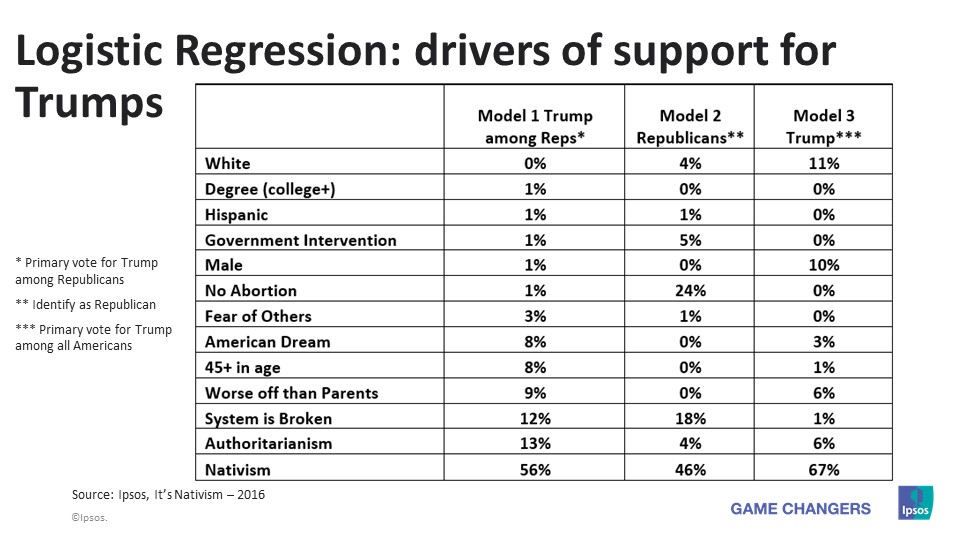
First, independent of model specification, nativism is the most important factor is defining support for Trump (as well as for identifying with the Republican Party). Indeed, when looking at primary support for Trump among Republicans, Nativism explains 56% of the impact, with other factors accounting for very little in a relative sense. Authoritarianism only accounts for 13% in model 1.
Second, when we broaden our universe and look at support for Trump among all Americans, we find that, indeed, nativism is very important (67%); all other factors are tertiary at best. We find a similar trend for identifying (or not) with being Republican: nativism (46%); anti-abortion (24%); and system is broken (18%). Again, in both models 2 and 3, we find that authoritarianism only has a marginal impact: 4% in model 2 and 6% in model 3.
Third, demographics, as a whole, explain very little of the overall impact. This varies from around 24% in model 3 to about only 5% in models 2. In the case of support for Trump among all Americans, being male and white explain about 20% of the impact.
Taken as a whole, this analysis strongly suggests that Trump finds his strength in a Republican base that is highly nativist in orientation. And this, on the whole, explains his support. On a secondary note, the empirical evidence also shows that voters who are more socially conservative and with populist tendencies also support him. Only on a tertiary level do other factors—both ideological and demographic—play a role.
Do we find similar trends with different methods? What do we find with Bayes net?
Bayes Net Analysis
The simple answer is yes; we do find similar trends. It’s all about nativism!
There are many versions of Bayesian network analysis—all, though, attempt to determine the underlying multivariate structure of the data. Such approaches, in turn, are simulation-based and wouldn’t be possible if it weren’t for the advent of cheap computing power.
I employ a proprietary approach developed at Ipsos, known as Ipsos Bayes Net, or IBN.[8] Like other Bayesian network approaches, IBN is a simulation-based method which performs hundreds of bootstrap samples. Ultimately, the model tests all possible interactions among the variables and then estimates the impact of each factor on the dependent variable controlling for all other factors. The IBN impact measures are like unstandardised regression coefficients and can be thought of in relative terms to determine the size of the impacts.
Again, for easy perusal, I have set Nativism at 100% and all other factors indexed to Nativism. So a value greater than 100% means that the given factor has a greater impact on support for Trump than Nativism. In contrast, if the value is less than 100%, it means that the factor has a weaker impact on support than Nativism does. Additionally, if a measure, let’s say Authoritarianism, has an impact value of 25%, this means that Nativism has a 4x greater impact on support for Trump than Authoritarianism (4=100/25).
So what do we find?
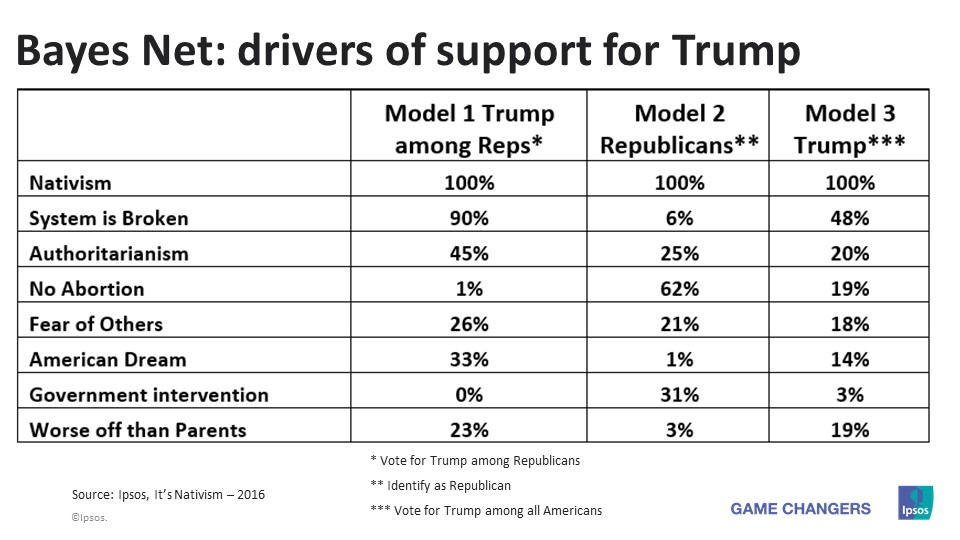
First, quite simply, across all three models, nativism is the key driver. Support for Trump is, indeed, a function of people’s degree of nativist belief: the more nativist in orientation the person is, the more likely they are to support Trump. The same relationship, in turn, exists between identifying as a Republican and Nativism: the more nativist, the more likely to identify as a Republican.
Second, system is broken is an important secondary factor. The more likely people are to believe that the system is broken, the more likely they are to support Trump. In the case of identifying as Republican, system is broken plays only a small role, in contrast to the logistic regression results. Abortion, in contrast, is a much more important explanatory factor in identifying as a Republican.
Third, similar to our logistic regression analysis, Authoritarianism only plays a weak secondary role in explaining support for Trump. Note we don’t exhibit demographic controls here, but the results don’t change substantively.
Neuro Nets
Our Bayes Net approach also attempts to identify the relationship between the outcome variable and the explanatory factors from a causal perspective. Of course, any analysis of cause and effect with observational data, like that found in most polls, is a crude approximation at best. Ideally, we would love to have a controlled experiment in order to isolate the key drivers causally. But, given the impossibility of this in practice, crude approximations are all we have, and all we often need.
Specifically, IBN employs the PC algorithm[9] to identify the causal sequencing of the different explanatory factors. These variable clusters or sequences can be portrayed visually in maps which make for easy intuitive understanding.
In practice, these maps represent, imperfectly, our belief, or memory, clusters from a cognitive perspective. Practically applied, they provide insight into which ‘hot buttons’ to push and how to sequence and frame messages.
Here we look at two Bayes net maps for models 1 and 2. So what do we find?
In the case of primary support for Trump among all voters, quite simply all explanatory factors work through nativism. Put differently, those who support Trump do so because they see all the issues (big government, social conservatism, the system is broken, being worse off than parents, etc.) through the lens of anti-immigrant sentiment and nativism.
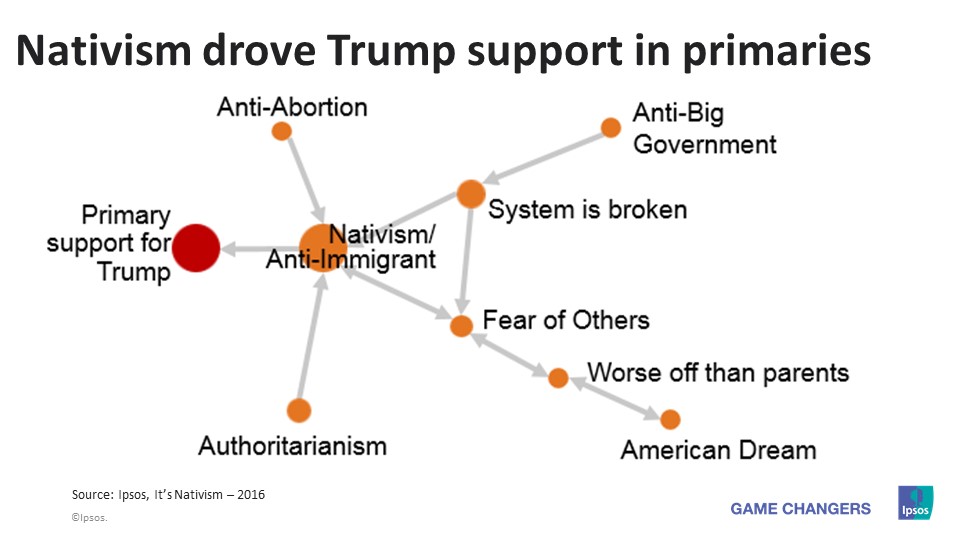
When we examine the neuro map for identifying as a Republican, the logic is more complex. Indeed, both social conservatism and small government both have independent impacts on the likelihood of someone identifying as a Republican: people who are more socially conservative and believe the government should be smaller are more likely to be Republicans These results reinforce both our practical understanding and academic research on the historical drivers of identifying as Republican.
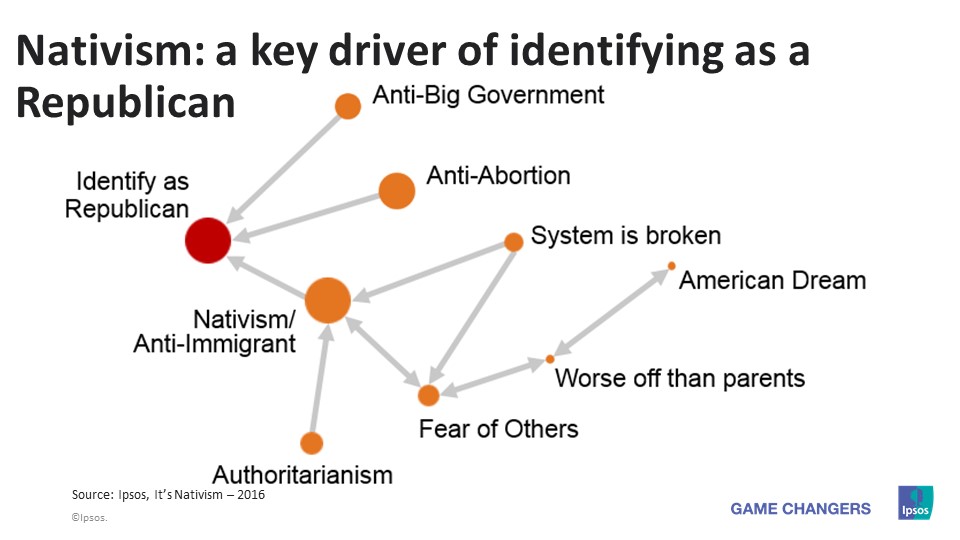
However, our Bayes net analysis identifies a third and more impactful dimension for identifying as a Republican: nativism. Specifically, those who believe that the system is broken, the future is bleak, and the American dream is dead, all see these worries as an anti-immigrant issue—strong Trump territory and one which he has helped shape and frame.
For me, key is whether this nativist dimension is pre-existing (pre-Trump) or something that Trump has molded and framed. Only an historical analysis of public opinion data will shed light on this.
Conclusion and Reflections
So ultimately what did we find?
First and foremost, the basis for Trump’s popular support is nativist, anti-immigrant, and America-first in nature. All other possible factors are secondary or tertiary in importance. Put differently, Trump supporters see all the ills of the world through the prism of immigration and its perceived negative impact on their lives. Trump, in turn, has offered himself as a solution to this problem.
For the primaries, Trump’s nativist wave has brought him the nomination. What about the general election?
I believe that the central question here is: can Trump ‘water down’ his nativist message in order to be more appealing to the average American voter? AND will he be credible enough to the average voter in doing this? The general election will hinge on his effectiveness in this reframing effort.
Second, many analysts understand Trump’s anti-immigrant rhetoric as really a symptom of a more profound problem of globalization and the corresponding economic dislocation that comes with it. In this context, immigration and Immigrants are the bogeymen for populist adventurers who take advantage of voter fear and uncertainty about the future. From this perspective, Trump, Brexit and Western Europe’s right-wing parties can all be understood in economic terms: immigrants are perceived as the cause of long-term economic uncertainty.
I believe that this only tells part of the story. Indeed, the demographic data also tell an equally compelling tale. As of 2014, 13.3% of the US population was foreign born—totaling 45 million Americans! At no time since the turn of last century has the US had such a high percent of foreign residents. Historical studies show that spikes in foreign born have correspondingly resulted in increased nativist public opinion and restrictive legislation[10].
Additionally, the 2011 birth cohort was the first in American history to be more non-white than white. This is significant, in my mind, because it reinforces among many Americans the profound demographic changes at hand and their impact on cultural identity at the level of symbols and meaning.
Finally, many also understand Trump and this more global nativist phenomenon as new and on the rise. On this point, the public opinion data tells a nuanced story: support or belief in nativism is not on the rise. Instead, it has been relatively flat lined or even been declining over the last 20 years depending on the question wording. Pew data suggests that long-term it is on the decline as Millennials are much less nativist than older generations.
That said, nativist attitudes and anti-immigrant rhetoric has become more polarised politically. Twenty years ago Republican and Democrats were about equally likely to be nativist. Nowadays, Republicans are almost twice as likely to hold such beliefs compared to Democrats (see table below).
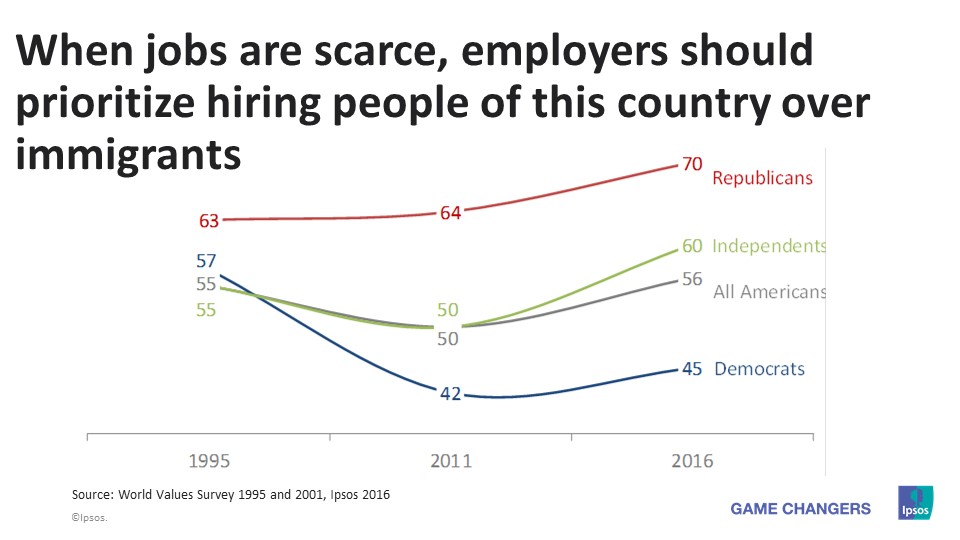
In political terms, whereas nativism was a non-issue a quarter century ago, it will increasingly play a role in the political arena for the foreseeable future.
Ultimately, the key question here is what nativism means for the Republican Party. It is too early to say whether or not we are witnessing a wholesale party realignment. I think not. That said, in the short to medium term, the nativist backlash could have profound effects on the Republican party and American politics in general. The exact outcome, however, is still to be determined.
In the long term, nativism looks to be a losing proposition as younger generations look to be less nativist than older ones. Between now and then American politics should be a wild ride.



